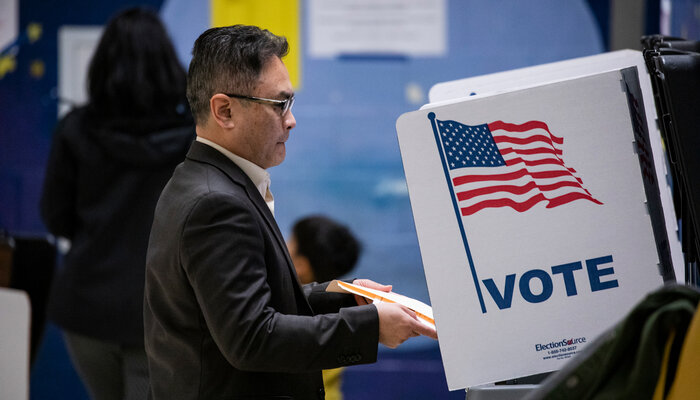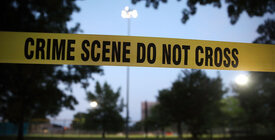The U.S. election system has multiple guardrails to ensure that only legitimate votes are counted. There is simply no evidence to support claims that election fraud is widespread. Below, we separate fact from fiction.
FACT #1: States have myriad checks in place to make sure that only eligible U.S. citizens can vote.
Myth vs. Fact: Under federal and state law, only U.S. citizens can vote in state and federal elections. To register to vote, a person must swear to their U.S. citizenship under penalty of criminal prosecution. Election processes are full of checks to identify ineligible voter registrants.
Under federal law, states are required to conduct regular list maintenance to remove ineligible voters from the rolls. Many states also participate in the Electronic Registration Information Center, which allows members to compare their voter rolls across state lines and ensure that lists are accurate and up-to-date.
All voters’ names and addresses are recorded, and ineligible voters face severe penalties, including jail time or deportation. A noncitizen working toward naturalization can be denied citizenship for being registered to vote.
FACT #2: The Uniformed and Overseas Citizens Absentee Voting Act guarantees that U.S. troops and other citizens serving our country abroad can exercise their right to vote.
Myth vs. Fact: Conspiracy theorists spreading lies about noncitizens illegally voting have targeted this long-standing program, which enables military service members, missionaries, aid workers, and other U.S. citizens living overseas to vote.
In 1986, President Ronald Reagan signed the Uniformed and Overseas Citizens Absentee Voting Act (UOCAVA), giving military members and other U.S. citizens living abroad the right to register to vote and cast an absentee ballot in federal elections. Without that law, troops serving our country, missionaries, aid workers, and other citizens living abroad would be disenfranchised.
A rigorous system of checks ensures that only eligible U.S. citizens can vote from abroad. Among other steps, they must provide a residential address in the United States and their signature to register.
Americans living overseas cannot choose any state to vote in — they must vote in the last state they lived in. We should do everything we can to guarantee that they can vote, not bash the system that allows them to do so.
FACT #3: Voting by mail and using drop boxes are safe and trustworthy ways to vote thanks to multiple layers of security.
Myth vs. Fact: Mail voting is a deep-rooted practice in the United States. Still, its increased use in recent years has led to false allegations that the practice is vulnerable to widespread fraud and tampering. The reality is that mail ballots have been successfully used in U.S. elections for more than 150 years, and in that time, states have developed numerous layers of security to protect against malfeasance.
Practices vary by state, but every state has a well-tested and multilayered system of checks to ensure the security of mail voting. Thirty-one states use signature comparison to verify mail ballots. Some election officials even receive law enforcement training in detecting forgeries. Forty-two states require voters to request a mail ballot. These requests go through a verification process in which election workers compare the request to the voter’s registration record to make sure that each ballot is mailed to the correct voter and that only one ballot is sent per voter. The remaining eight states send mail ballots to every eligible voter each election; frequent mailings help keep voter registration records up-to-date so that ballots are sent to eligible voters at their current address.
Voter fraud related to ballots sent by mail or placed in drop boxes is extremely rare — a person is statistically more likely to be struck by lightning than to commit mail ballot fraud. If voter fraud does occur, these security checks enable election officials to prevent ineligible ballots from being counted. They also help law enforcement hold offenders accountable.
FACT #4: Election officials audit voting machines at every step of the process to make sure that votes are recorded correctly.
Myth vs. Fact: Conspiracy theories about hacked voting machines have proliferated since the 2020 presidential election. Ensuring the security of election technology is critical. However, rumors about dysfunctional voting machines ignore the numerous security measures in place to prevent, catch, and recover from any technical errors.
There is no such thing as an invulnerable technology, which is why states deploy a series of safeguards and checks to ensure the accuracy of final vote counts. While each state’s procedures are different, these are among the most common: voting machines are certified to federal and state security standards before being deployed, tested before voters cast their ballots to make sure they are working properly, and audited again after elections to confirm that they correctly counted ballots and produced an accurate total. Importantly, 99 percent of voters live in jurisdictions where they can cast a ballot with a paper record of their vote, which can be used to verify that electronic totals are correct.
FACT #5: States have multiple systems in place to update voter rolls and continually improve their accuracy.
Myth vs. Fact: Voter rolls have received increased attention in recent years as conspiracy theorists have falsely claimed that inaccurate rolls have led to widespread fraud.
All citizens must affirm that they are eligible to vote in their state and jurisdiction before they are added to the voter rolls. Under federal law, a person registering to vote for the first time must present an approved ID.
Federal and state law require election officials to maintain voter rolls and continually verify their accuracy. Federal law requires states to remove voters who have died, moved, or otherwise become ineligible. Election officials have adopted various practices to do so, including regularly cross-checking voter rolls with state and federal agencies and other sources that track deaths and changes of address.
Even when rolls contain voters who are no longer eligible because they moved or passed away prior to the rolls being updated, there are additional steps in place to prevent these outdated or ineligible registrants from voting and to bar others from casting ballots on their behalf.
FACT #6: State certification laws require officials to sign off on results that election workers have carefully counted and double-checked through strict, predetermined procedures.
Myth vs. Fact: Seizing on false — and repeatedly debunked — allegations of fraud, conspiracy theorists have pressured election officials not to certify results and have occasionally convinced officials to shirk their mandatory duty. While courts and state officials have successfully intervened each time, rumors persist that individual officials can tamper with the certification process.
An example of how this can play out can be found in the initial refusal of county commissioners in Otero County, New Mexico, to certify the 2022 primary election results. The commissioners reversed their decision after being ordered to do so by the state supreme court, though one member refused to comply, citing a “gut feeling” that the process could not be trusted. Although he was removed from his position for unrelated reasons, the secretary of state’s office had reportedly considered pursuing criminal charges for failure to adhere to the court’s order.
Each state has preset procedures and timelines for how election officials count ballots and finalize results after the polls close. After a series of checks that confirm the accuracy of the results, officials sign off on them in a final step called certification. Certification is a legally mandated, nondiscretionary duty. The certification process is typically narrow in scope; state laws lay out legal channels to pursue in the event that a candidate alleges electoral fraud. Officials typically review the unofficial results and certify results at meetings that are open to the public, and many states assign these responsibilities to joint teams of Republicans and Democrats.
FACT #7: Results are never final on Election Day. Election workers need time to ensure that all legitimate votes are counted.
Myth vs. Fact: New batches of ballots are added to vote totals in the hours and days (and sometimes weeks) following an election, and sometimes those ballots come from groups that vote similarly, such as those voting by mail or those from a certain area. As those batches of ballots are counted, the candidate in the lead often changes, especially in close races. Conspiracy theorists have seized on this fact to falsely claim that election workers are cheating and that ballots counted after polls close are not legitimate.
Results are not available on election night for various reasons, including the fact that not all votes are received by the time polls close. The Constitution allows states to establish their own rules and timelines for when and how votes can be counted. For instance, in some states, mail ballots must be received by Election Day to be counted, while in others, ballots can be counted as long as they are postmarked by Election Day. The 21 states that fall into the second category often do not receive all ballots by the time polls close, and election officials need time to verify that these votes are valid and count them. These include ballots from military members deployed overseas.
States also have the right to determine when mail ballots can be processed, which involves verifying those voters’ eligibility and removing the ballots from their envelopes so they can be counted. Whereas most states allow election workers to process mail ballots early, six states — including the swing states Pennsylvania and Wisconsin — prohibit ballot processing before Election Day. This delay significantly slows the pace at which election workers can count mail ballots and release results.
Once all votes have been counted, election officials conduct audits to confirm that vote totals are accurate.
• • •
Those seeking to undermine confidence in American elections, including foreign nation states seeking to denigrate U.S. democracy and incite violence, rely on false narratives that get repeated from election cycle to election cycle. Ensuring that Americans have accurate voting information is critical to defending Americans and our democracy from this false information.







